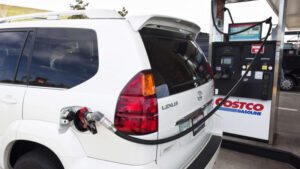Winter Weather Can Zap Almost One Third of Your EV's Range

Photo: Artur Widak/NurPhoto (Getty Images)
Cold weather conditions are the bane of every single EV’s existence, anecdotally. Lower temperatures are well known to lower the mile range of EVs, but just by how much has remained a question for prospective EV buyers. Now that more fully-electric cars are old enough to have seen their first winter, the studies are in and they show that some EVs can handle the cold better than others.
Researchers and battery scientists at Recurrent Motors took a look at how cold weather affects the real-world range of some of the most popular EVs, including the Chevy Bolt, Tesla Model 3, Volkswagen ID.4 and Ford Mustang Mach-E.
Under Recurrent’s testing conditions, the range of the VW ID.4 and Ford Mustang Mach-E took the biggest hit with 30 percent lower range in lower temperatures — between 20 to 30 degrees Fahrenheit for the purposes of the study. The Jaguar I-Pace and Audi E-Tron fared the best, with an estimated lower range of just three and eight percent, respectively. Wow, Jaguar, that’s one cool cat.
It’s worth mentioning that the lower ranges only apply in lower temperatures, and once temperatures go up, the EV mile ranges do so, too. It’s also worth noting the data from Recurrent tries to reflect real-world range, so it takes into account more than just cold weather. From the study:
This chart compares 14 popular EV models to show range loss in different driving conditions. It includes aggregated and anonymized data from 7,000 vehicles in the Recurrent community from across the United States as well as tens of thousands of data points from on-board devices that provide data on energy usage.
The estimated winter range for several vehicles has been updated in 2022 to reflect the winter range that we have verified with real-world data. We will continue to update this chart as we verify new models.
Verified winter range figures include all real-world variables, such as uneven terrain, variable driving speeds and uses, and calendar aging in vehicle batteries. They show the average expectation for winter driving conditions in a range of real use cases.
The study goes more in depth with individual EV model stats, but the overall effects of the cold are in the chart above. All EVs are going to experience some degree of range loss in the winter because lower temperatures “inhibit chemical reactions and slow down the physical processes” at work in EV battery packs, as Recurrent explains.
Because of this, many EVs use clever technology such as heat pumps or other thermal management to keep their batteries closer to the optimal operating temperature, but these devices need power to run. If you’re a cold-weather car veteran, you’ll be familiar with the basics, but the difference is EV drivers are vying with the batteries in their cars for warmth.
Combustion-powered cars make excess heat that can easily be dumped back into the cabin. EVs are more cold-blooded, in a sense, since they need to keep themselves warm by redirecting excess heat to their batteries. Long story short, if you own an EV and plan to minimize range loss in the winter, just make sure to bundle up and share the heater with your battery.
Photo: Arterra/Universal Images Group (Getty Images)


